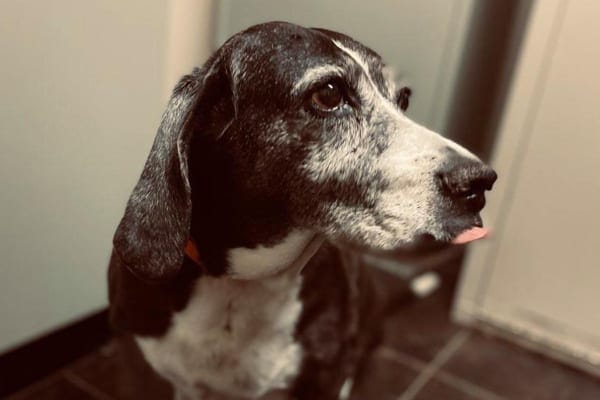Why is my older dog losing teeth?
If you’ve noticed your senior dog losing teeth and you can’t chalk it up to a fall, slip, or other form of trauma, it’s quite possible your dog has some degree of periodontal disease (i.e. dental disease).

Periodontal disease is inflammation or infection of the tissues around the teeth. These include the gums (or gingiva), the periodontal ligament that anchors the tooth in place, and the alveolar bone that surrounds the tooth roots.
Periodontal disease is one of the most common health problems diagnosed by veterinarians. It is estimated that over 80% of adult dogs will develop some degree of periodontal disease by the time they are three years old.
This disease starts when plaque, a sticky substance made from saliva mixed with food particles, builds up on the teeth. Bacteria in the plaque can cause an inflamed gum line (i.e. gingivitis) and infect the alveolar bone surrounding the teeth.
Plaque can be removed from the teeth by consistent routine brushing, but if allowed to remain, over time it will harden into tartar (i.e. calculus). This tartar cannot be removed by brushing alone. It’s like cement on the teeth.
As tartar accumulates, inflammation increases and bone loss occurs. When alveolar bone loss exceeds 50%, teeth loosen and fall out on their own.
If your vet suspects periodontal disease, he or she will classify the disease into one of the following stages. Dental X-rays under general anesthesia will help your veterinarian determine the stage of periodontal disease.
Complications of Untreated Gum Disease
Without treatment, gum disease continues to worsen, causing your dog more and more pain. Eventually, the affected teeth will start to loosen and even fall out. Without teeth there to act as an anchoring structure, the jawbone will start to recede. As the most advanced stage of gum disease, dogs can suffer up to 50 percent bone loss in their jaw. Their ability to pick up and chew food diminishes greatly with the tooth and jawbone loss.
As a result of the pain and inability to eat properly, dogs can start to develop behavioral problems, such as aggression toward people. Proper treatment can help reverse damage to your dog’s oral structures before these habits become ingrained.
Just as in humans, if gum disease is not treated there is a significantly increased chance of heart disease, diabetes, and even cancer.
Early Symptoms of Tooth Loss in Dogs
When the loose teeth are trauma related, you may notice your dog exhibiting signs of swelling or pain in the injured area. Bleeding around the tooth could also occur due to damage to the gum tissue and tooth structure.
When the loose teeth are caused by gum disease, however, much subtler signs indicate there is an issue. In the early stages of gum disease, there are usually no symptoms at all, though some dogs have gum swelling around the periodontal pockets. The swelling results from the buildup of plaque along the gumline and within the pockets around each tooth.
As plaque builds up and the disease progresses, however, the swelling may affect all of the gum tissues and cause the gums to deepen in color. In addition, the gum tissue may recede, revealing more of the tooth structure and loosening its connection in the socket. Bad breath and bumps on the gum tissue are also common.
With gum swelling and discoloration comes pain, which may show in the form of eating difficulties. If you notice a difference in your dog’s eating patterns without a known cause, your veterinary dentist can help you determine if gum disease or loose teeth are a contributing factor.